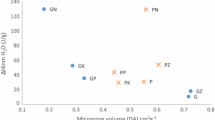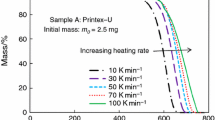Abstract
The surface activity of different types of carbon black with phenolic antioxidants is examined using flow micro-calorimetry (FMC), X-ray Photoelectron Spectroscopy (XPS) and Fourier Transform Infrared spectroscopy (FTIR). Significant differences in both the overall adsorption activity and the levels of probe adsorption are observed. Differences in behaviour between types of carbon black are evident and show that the specific surface area is not the most important factor affecting the adsorption activity, but also the chemical nature of its surface. Essentially, two factors were found to affect the behaviour of phenolic stabilisers: Phenolic hydroxyl and ester groups were found to form the strongest interactions with carbon black. Furthermore, steric hinderance of phenolic hydroxyls by alkyl groups is the main factor which influences adsorption activity. In order to characterise different carbon blacks, FTIR and XPS analysis have been used in an attempt to determine the nature of functional groups present on the surface of the carbon blacks. FTIR analysis also shows that some adsorbed antioxidants on the surface of the carbon black could be successfully detected. This provides valuable information regarding the adsorption mechanisms on to carbon black surfaces. Other techniques included thermogravimetric analysis (TGA), N2 BET adsorption studies and Karl Fisher analysis. The latter were performed in order to determine differences in the volatile and water contents, respectively, of the carbon black samples.
Similar content being viewed by others
References
S. Bandyopadhyay and D. K. Tripaty, J. Appl. Sci. 58 (1995) 719.
J. Wolfschewenger, A. Hauer, M. G. Gahleitner and W. Nei ß l, in Proceedings Eurofillers' 97 (British Plastics Federation, Manchester, UK, 1997) p. 375.
C. M. Liauw, A. Childs, N. S. Allen, M. Edge, K. R. Franklin and D. G. Collopy, Polym. Degrad. Stab. 65 (1999) 207.
A. P. D'silva, Carbon 36 (1998) 1317.
J. B. Donnet, R. C. Bansal and M. J. Wang, “Carbon Black, Science and Technology” (Marcel Dekker Inc., New York, 1993).
M. H. Polley, W. D. Schaeffer and W. R. Smith, J. Am. Chem. Soc. 73 (1951) 2161.
M. J. Wang, S. Wolff and J. B. Donnet, Rubb. Chem. Technol. 64 (1991) 714.
A. I. Medalia, “Carbon Black” (Medalia Associates, Inc., Mass., USA, 1991).
J. A. MenÉndez, Thermochimica Acta 312 (1998) 79.
A. J. Grozeck, Proc. Roy. Soc. London A314 (1970) 473.
Idem., Carbon 6 (1987) 717.
A. J. Grozeck and G. Aharoni, Langmuir 15 (1999) 5956.
F. M. Fowkes, “Acid-Base Interactions,” edited by K. L. Mittal and H. R. Anderson (VPS, Zeist, The Netherlands, 1991).
S. T. Joslin and F. M. Fowkes, IEC Prod. R&D 24 (1985) 369.
D. P. Ashton and R. N. Rothon, “Controlled Interfaces in Composite Materials,” edited by H. Ishida (Elsevier, Amsterdam, 1990).
C. M. Liauw, A. Childs, N. S. Allen, M. Edge, K. R. Franklin and D. G. Collopy, Polym. Degrad. Stab. 63 (1999) 391.
R. N. Rothon, “Particulate Filled Polymer Composites,” edited by R. N. Rothon (Longman Scientific, London, UK, 1996).
C. M. Liauw and S. J. Read, Confidential Report to Cabot Corporation, Billerica, Boston, USA, 1998.
C. M. Liauw, R. N. Rothon, S. J. Hurst and G. C. Lees, Composite Interfaces 5 (1998) 503.
Cabot North American Technical Report S-136, Cabot Corporation, 1999.
H. P. Boehm, Carbon 32 (1994) 759.
R. H. Bradley, I. Sutherland and E. Sheng, J. Colloid Interface Sci. 179 (1996) 561.
I. Sutherland, E. Sheng and R. H. Bradley, J. Mater. Sci. 31 (1996) 5651.
J. M. O'reilly and R. A. Mosher, Carbon 21 (1983) 47.
E. Papirer and R. Lacroix, ibid. 32 (1994) 1341.
B. WesslÉn, M. Kober, C. Freijlarsson, A. Ljungh and M. Paulsson, Biomaterials 15 (1994) 278.
E. Österberg and K. BergstrÖm, Appl. Surface Sci. 64 (1995) 197.
T. Asakawa, K. Ogino and K. Yamabe, Bull. Chem. Soc. Japan 58 (1985) 2009.
T. J. Fabish and D. E. Schleifer, Carbon 22 (1984) 19.
Author information
Authors and Affiliations
Corresponding author
Rights and permissions
About this article
Cite this article
Peña, J.M., Allen, N.S., Edge, M. et al. Factors affecting the adsorption of stabilisers on to carbon black (flow micro-calorimetry and FTIR studies) Part I Primary phenolic antioxidants. Journal of Materials Science 36, 2885–2898 (2001). https://doi.org/10.1023/A:1017998202931
Issue Date:
DOI: https://doi.org/10.1023/A:1017998202931




